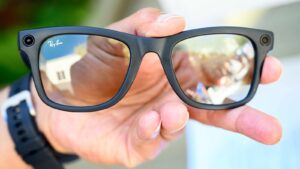Samsung is preparing to enter the competitive world of wearable extended reality (XR) devices with the announcement of its first XR glasses, set to launch in the third quarter of 2025. The device is expected to include features similar to Meta’s Ray-Ban Stories while introducing Samsung’s distinctive technological advancements. This move signals Samsung’s intent to solidify its place in the XR market, which has seen rapid growth due to consumer interest and advancing technology.
The development of XR devices marks a significant shift in how technology integrates with daily life. Samsung, known for its innovative display technology and ecosystem of devices, is poised to leverage its expertise to create a product that blends style with functionality. While Meta’s Ray-Ban Stories introduced features like hands-free calling and photo capture, Samsung is likely to go a step further by embedding augmented reality and virtual reality experiences into its glasses. These additions could redefine user interaction with wearable technology.
Reports indicate that Samsung’s XR glasses will seamlessly connect with its ecosystem of products, including smartphones, tablets, and smart TVs. This approach underscores Samsung’s commitment to providing a unified and cohesive user experience. Unlike standalone devices, the XR glasses will work in harmony with other Samsung gadgets, allowing users to perform a range of tasks more efficiently.
Understanding XR and Samsung’s Vision
Extended reality is a combination of augmented reality (AR), virtual reality (VR), and mixed reality (MR), offering immersive experiences that overlay virtual elements onto the real world or create entirely digital environments. Samsung’s XR glasses will likely focus on striking a balance between enhancing productivity and providing entertainment. The glasses could enable users to navigate complex tasks, participate in virtual meetings, or enjoy immersive gaming experiences without the need for bulky headsets.

Samsung’s history of technological innovation places it in an excellent position to create a competitive XR device. The company’s leadership in OLED and AMOLED display technology will play a critical role in delivering high-resolution visuals for the glasses. This could significantly enhance the realism of virtual elements, setting Samsung apart from competitors that use less advanced displays.
The inclusion of artificial intelligence (AI) is another anticipated feature, allowing for smarter and more intuitive user interactions. Voice commands, powered by a refined version of Samsung’s AI assistant Bixby, are expected to provide hands-free functionality. This would make the glasses particularly useful for professionals who need quick access to tools or information while multitasking.
How Samsung’s XR Glasses Compare to Meta’s Ray-Ban Stories
Meta’s Ray-Ban Stories, a collaboration with EssilorLuxottica, have gained popularity for integrating smart features into a fashionable frame. These glasses enable users to take photos, make calls, and listen to music. However, their functionality is limited compared to the immersive experiences XR devices promise.
Samsung’s XR glasses will likely expand on this foundation by incorporating XR-specific features such as 3D object interaction and immersive content viewing. The table below highlights key distinctions between the two products based on available information:
Features to Watch in Samsung’s XR Glasses
Samsung’s XR glasses are expected to cater to a wide audience, from gamers to professionals. Reports suggest the device will feature high-performance processors, possibly co-developed with Qualcomm, to handle complex XR applications. Combined with advanced sensors, the glasses could enable precise hand tracking and gesture-based controls.
The integration of cameras capable of real-time translation and object recognition could also be a game-changer for travelers and business users. By leveraging augmented reality overlays, these glasses could guide users through unfamiliar environments, provide instant information about objects, or offer step-by-step instructions for tasks.
For entertainment, the glasses are expected to provide immersive visuals powered by Samsung’s expertise in display technology. Users could watch movies, play games, or explore virtual worlds with lifelike clarity. In professional settings, the glasses may allow users to collaborate in virtual spaces, enhancing remote work productivity.
The Competitive XR Market
The XR market is experiencing rapid growth, driven by advancements in hardware, software, and connectivity. Companies like Meta, Apple, and Microsoft have already introduced devices that cater to different aspects of XR. Samsung’s entry into this space adds a formidable competitor with a proven track record in consumer electronics.
Apple’s Vision Pro, for instance, focuses on high-end AR and productivity, while Meta’s Quest series prioritizes affordable VR gaming. Samsung’s XR glasses will likely aim for a middle ground, offering versatile functionality at a competitive price. By targeting mainstream consumers, Samsung could accelerate the adoption of XR technology.
Analysts predict that the global XR market will exceed $100 billion by 2025, making it one of the fastest-growing segments in the tech industry. As more companies invest in XR development, the technology is becoming increasingly accessible to everyday users.
Why Samsung’s Launch Matters
The third-quarter launch aligns with Samsung’s strategy of introducing products when consumer interest is high and the technology is mature. By 2025, advancements in 5G and AI are expected to make XR devices more practical and appealing. Samsung’s timing allows it to incorporate these innovations while addressing challenges faced by early adopters of XR technology.
This launch also highlights Samsung’s broader vision for wearables as part of a connected ecosystem. The glasses could encourage users to adopt other Samsung products, creating a network of devices that work seamlessly together. This approach not only strengthens customer loyalty but also positions Samsung as a leader in the tech industry.
The Future of XR and Samsung’s Role
Samsung’s XR glasses represent a significant step forward in wearable technology. By combining style, functionality, and immersive experiences, these glasses could redefine how users interact with technology. Whether it’s for entertainment, work, or daily tasks, XR devices have the potential to transform multiple aspects of life.
As Samsung prepares for the 2025 launch, the anticipation surrounding its XR glasses reflects the growing interest in extended reality. The company’s expertise in hardware and software positions it as a strong contender in the XR market, setting the stage for exciting developments in the years ahead.









Add Comment